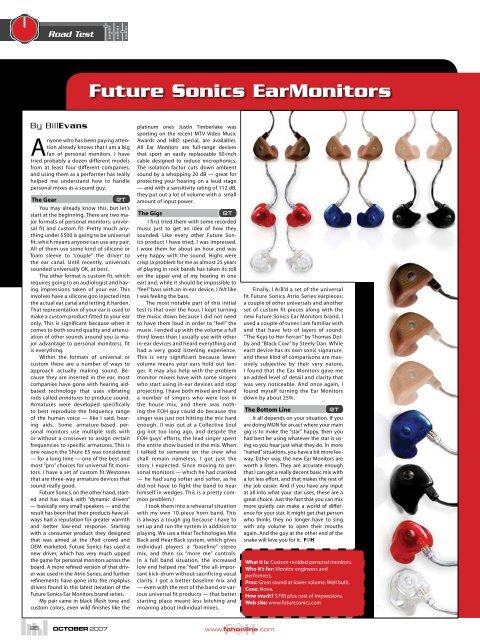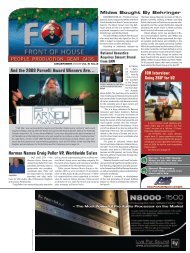Create successful ePaper yourself
Turn your PDF publications into a flip-book with our unique Google optimized e-Paper software.
26<br />
Road Test<br />
By BillEvans<br />
Anyone who has been paying attention<br />
already knows that I am a big<br />
fan of personal monitors. I have<br />
tried probably a dozen different models<br />
from at least four different companies,<br />
and using them as a performer has really<br />
helped me understand how to handle<br />
personal mixes as a sound guy.<br />
The Gear RT<br />
You may already know this, but let’s<br />
start at the beginning. There are two major<br />
formats of personal monitors: universal<br />
fit and custom fit. Pretty much anything<br />
under $500 is going to be universal<br />
fit, which means anyone can use any pair.<br />
All of them use some kind of silicone or<br />
foam sleeve to “couple” the driver to<br />
the ear canal. Until recently, universals<br />
sounded universally OK, at best.<br />
The other format is custom fit, which<br />
requires going to an audiologist and having<br />
impressions taken of your ear. This<br />
involves have a silicone goo injected into<br />
the actual ear canal and letting it harden.<br />
That representation of your ear is used to<br />
make a custom product fitted to your ear<br />
only. This is significant because when it<br />
comes to both sound quality and attenuation<br />
of other sounds around you (a major<br />
advantage to personal monitors), fit<br />
is everything.<br />
Within the formats of universal or<br />
custom there are a number of ways to<br />
approach actually making sound. Because<br />
they are inserted in the ear, most<br />
companies have gone with hearing aidbased<br />
technology that uses vibrating<br />
rods called armatures to produce sound.<br />
Armatures were developed specifically<br />
to best reproduce the frequency range<br />
of the human voice — like I said, hearing<br />
aids. Some armature-based personal<br />
monitors use multiple rods with<br />
or without a crossover to assign certain<br />
frequencies to specific armatures. This is<br />
one reason the Shure E5 was considered<br />
— for a long time — one of the best and<br />
most “pro” choices for universal fit monitors.<br />
I have a set of custom fit Westones<br />
that are three-way armature devices that<br />
sound really good.<br />
Future Sonics, on the other hand, started<br />
and has stuck with “dynamic drivers”<br />
— basically very small speakers — and the<br />
result has been that their products have always<br />
had a reputation for greater warmth<br />
and better low-end response. Starting<br />
with a consumer product they designed<br />
that was aimed at the iPod crowd and<br />
OEM marketed, Future Sonics has used a<br />
new driver, which has very much upped<br />
the game for personal monitors across the<br />
board. A more refined version of that driver<br />
was used in the Atrio Series, and further<br />
refinements have gone into the mg4plus<br />
drivers found in this latest iteration of the<br />
Future Sonics Ear Monitors brand series.<br />
My pair came in black (flesh tone and<br />
custom colors, even wild finishes like the<br />
Future Sonics EarMonitors<br />
platinum ones Justin Timberlake was<br />
sporting on the recent MTV Video Music<br />
Awards and HBO special, are available).<br />
All Ear Monitors are full-range devices<br />
that sport an easily replaceable 50-inch<br />
cable designed to reduce microphonics.<br />
The isolation factor cuts down ambient<br />
sound by a whopping 20 dB — great for<br />
protecting your hearing on a loud stage<br />
— and with a sensitivity rating of 112 dB,<br />
they put out a lot of volume with a small<br />
amount of input power.<br />
The Gigs RT<br />
I first tried them with some recorded<br />
music just to get an idea of how they<br />
sounded. Like every other Future Sonics<br />
product I have tried, I was impressed.<br />
I wore them for about an hour and was<br />
very happy with the sound. Highs were<br />
crisp (a problem for me as almost 25 years<br />
of playing in rock bands has taken its toll<br />
on the upper end of my hearing in one<br />
ear) and, while it should be impossible to<br />
“feel” bass with an in-ear device, I felt like<br />
I was feeling the bass.<br />
The most notable part of this initial<br />
test is that over the hour, I kept turning<br />
the music down because I did not need<br />
to have them loud in order to “feel” the<br />
music. I ended up with the volume a full<br />
third lower than I usually use with other<br />
in-ear devices and heard everything and<br />
had a very good listening experience.<br />
This is very significant because lower<br />
volume means your ears hold out longer.<br />
It may also help with the problem<br />
monitor mixers have with some singers<br />
who start using in-ear devices and stop<br />
projecting. I have both mixed and heard<br />
a number of singers who were lost in<br />
the house mix, and there was nothing<br />
the <strong>FOH</strong> guy could do because the<br />
singer was just not hitting the mic hard<br />
enough. (I was out at a Collective Soul<br />
gig not too long ago, and despite the<br />
<strong>FOH</strong> guys’ efforts, the lead singer spent<br />
the entire show buried in the mix. When<br />
I talked to someone on the crew who<br />
shall remain nameless, I got just the<br />
story I expected. Since moving to personal<br />
monitors — which he had cranked<br />
— he had sung softer and softer, as he<br />
did not have to fight the band to hear<br />
himself in wedges. This is a pretty common<br />
problem.)<br />
I took them into a rehearsal situation<br />
with my own 10-piece horn band. This<br />
is always a tough gig because I have to<br />
set up and run the system in addition to<br />
playing. We use a Hear Technologies Mix<br />
Back and Hear Back system, which gives<br />
individual players a “baseline” stereo<br />
mix, and then six “more me” controls.<br />
In a full band situation, the increased<br />
low end helped me “feel” the all-important<br />
kick-drum without sacrificing vocal<br />
clarity. I got a better baseline mix and<br />
— even with the rest of the band on various<br />
universal fit products — that better<br />
starting place meant less bitching and<br />
moaning about individual mixes.<br />
OCTOBER 2007 www.fohonline.com<br />
Finally, I A/B’d a set of the universal<br />
fit Future Sonics Atrio Series earpieces,<br />
a couple of other universals and another<br />
set of custom fit pieces along with the<br />
new Future Sonics Ear Monitors brand. I<br />
used a couple of tunes I am familiar with<br />
and that have lots of layers of sound:<br />
“The Keys to Her Ferrari” by Thomas Dolby<br />
and “Black Cow” by Steely Dan. While<br />
each device has its own sonic signature,<br />
and these kind of comparisons are massively<br />
subjective by their very nature,<br />
I found that the Ear Monitors gave me<br />
an added level of detail and clarity that<br />
was very noticeable. And once again, I<br />
found myself turning the Ear Monitors<br />
down by about 25%.<br />
The Bottom Line RT<br />
It all depends on your situation. If you<br />
are doing MON for an act where your main<br />
gig is to make the “star” happy, then you<br />
had best be using whatever the star is using<br />
so you hear just what they do. In more<br />
“varied” situations, you have a bit more leeway.<br />
Either way, the new Ear Monitors are<br />
worth a listen. They are accurate enough<br />
that I can get a really decent basic mix with<br />
a lot less effort, and that makes the rest of<br />
the job easier. And if you have any input<br />
at all into what your star uses, these are a<br />
great choice. Just the fact that you can mix<br />
more quietly can make a world of difference<br />
for your star. It might get that person<br />
who thinks they no longer have to sing<br />
with any volume to open their mouths<br />
again. And the guy at the other end of the<br />
snake will love you for it.<br />
What it is: Custom-molded personal monitors.<br />
Who it’s for: Monitor engineers and<br />
performers.<br />
Pros: Great sound at lower volume. Well built.<br />
Cons: None.<br />
How much? $798 plus cost of impressions.<br />
Web site: www.futuresonics.com
















